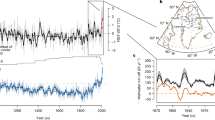Abstract
A study of glacial−interglacial periods shows that, once ice sheets reach a critical maximal mass, the glaciation period changes to an interglacial one; the latter gives way to the following glaciation period, during which the ice sheet mass becomes minimal. The last interglacial period, the Holocene, has been going on for more than 10 ka; this raises the question of the timing of the end of the Holocene and the beginning of the upcoming glaciation. The retrieval of detailed information on the mechanisms of climate change is connected with the study of ice sheets in Greenland and Antarctica, oceanic sediments, and continuous terrestrial proxy data. Long-term continuous data on the variability of land ice in Greenland and Antarctica provide valuable information on the climate variability pattern in the time intervals of the transition from glacial conditions to interglacial ones and vice versa. The data on temperature anomalies in Greenland and Antarctica are compared and analyzed here. The paper mainly focuses on the temperature variability pattern for the time interval of the transition from the last glacial maximum to the present moment (i.e., the temperature and trends in its changes are reconstructed).






Similar content being viewed by others
REFERENCES
Alder, J.R. and Hostetler, S.W., Global climate simulations at 3000-year intervals for the last 21 000 years with the GENMOM coupled atmosphere–ocean model, Clim. Past, 2015, vol. 11, no. 3, pp. 449–471. http://www.researchgate.net/publication/273764639.
AMAP, 2012. Arctic Climate Issues 2011: Changes in Arctic Snow, Water, Ice and Permafrost, SWIPA 2011 Overview Report, Oslo: AMAP, 2012.
Barker, S., Knorr, G., Edwards, R.L., Parrenin, F., Putnam, A.E., Skinner, L.C., Wolff, E., and Ziegler, M., 800,000 years of abrupt climate variability, Science, 2011, vol. 334, pp. 347–351. https://doi.org/10.1126/science.1203580
Bereiter, B., Shackleton, S., Baggenstos, D., et al., Mean global ocean temperatures during the last glacial transition, Nature, 2018, vol. 553, pp. 39–44.
Buizert, C., Gkinis, V., and Severinghaus, J.P., Greenland temperature response to climate forcing during the last deglaciation, Science, 2014, vol. 345, pp. 1177–1180.
Cuffey, K.M., Clow, G.D., Steig, E.J., et al., Deglacial temperature history of west Antarctica, Proc. Natl. Acad. Sci. U. S. A., 2016, vol. 113, no. 50, pp. 14249–14254.https://doi.org/10.1073/pnas.1609132113
Cuffey, K.M., Clow, G.D., Alley, R.B., et al., Large Arctic temperature change at the Wisconsin-Holocene glacial transition, Science, 1995, vol. 270, pp. 455–458.
Davis, W.J., Taylor, P.J., and Davis, W.B., The Antarctic centennial oscillation: A natural paleoclimate cycle in the Southern Hemisphere that influences global temperature, Climate, 2018, vol. 6, no. 1, p. 3.
Esper, J., Frank, D.C., Buntgen, U., et al., Northern European summer temperature variations over the common era from integrated tree-ring density records, J. Quat. Sci., 2014, vol. 29, no. 5, pp. 487–494.
Hannon, R., Paleoclimate cycles are key analogs for present day (Holocene) warm period, Clim. News, August 4, 2017.
Hannon, R., Modern warming—climate variability or climate change?, News Stud. Resour., March 18, 2018.
Heinemann, M., Timmermann, A., Timm, O.E., et al., 2014. Deglacial ice sheet meltdown: Orbital pacemaking and CO2 effects. http://www.clim-past.net/10/1567/2014. https://doi.org/10.5194/cp-10-1567-2014
Jouzel, J., Masson-Delmotte, V., Cattani, O., et al., Orbital and millennial Antarctic climate variability over the past 800 000 years, Science, 2007, vol. 317, no. 5839, pp. 793–796. https://doi.org/10.1126/science.1141038
Kaufman, D.S., Schneider, D.P., McKay, N.P., et al., Recent warming reverses long-term arctic cooling, Science, 2009, vol. 325, no. 5945, pp. 1236–1239.
Kindler, P., Guillevic, M., Baumgartner, M., et al., Temperature reconstruction from 10 to 120 kyr b2k from the NGRIP ice core, Clim. Past, 2014, vol. 10, pp. 887–902. https://doi.org/10.5194/cp-10-887-2014
Kotlyakov, V.M., The causes and consequences of present-day climate changes, Soln.-Zemnaya Fiz., 2012, no. 21, pp 110–114.
Marcott, S.A., Shakun, J.D., Clark, P.U., and Mix, A.C., A reconstruction of regional and global temperature for the past 11,300 years, Science, 2013, vol. 339, no. 6124, pp. 1198–1201. https://doi.org/10.1126/science.1228026
NEEM community members, Eemian interglacial reconstructed from a Greenland folded ice core, Nature, 2013, vol. 493, pp. 489–494. https://doi.org/10.1038/nature11789
Nicolas, J.P. and Bromwich, D.H., New reconstruction of Antarctic near-surface temperatures: multidecadal trends and reliability of global reanalyses, J. Clim., 2014, vol. 27, pp. 8070–8093. https://doi.org/10.1175/JCLI-D-13-00733.1
PAGES 2k Consortium, Continental-scale temperature variability during the past two millennia, Nature Geosci., 2013, vol. 6, pp. 339–346. https://doi.org/10.1038/NGEO1797
Shakun, J.D. and Carlson, A.E., A global perspective on Last Glacial Maximum to Holocene climate change, Quat. Sci. Rev., 2010, vol. 29, pp. 1801–1816.
Shakun, J.D., Clark, P.U., He, F., et al., Global warming preceded by increasing carbon dioxide concentrations during the last deglaciation, Nature, 2012, vol. 484, pp. 49–55.
Stenni, B., Curran, M.A.J., Abram, N.J., et al., Antarctic climate variability on regional and continental scales over the last 2000 years, Clim. Past, 2017, vol. 13, pp. 1609–1634. https://doi.org/10.5194/cp-13-1609-2017
Tabone, I., Blasco, J., Robinson, A., et al., The sensitivity of the Greenland ice sheet to glacial–interglacial oceanic forcing, Clim. Past, 2018, vol. 14, pp. 455–472. https://doi.org/10.5194/cp-14-455-2018
Vinther, B.M., Buchardt, S.L., Clausen, H.B., et al., Holocene thinning of the Greenland ice sheet, Nature, 2009, vol. 461, pp. 385–388. https://doi.org/10.1038/nature08355
Werner, M., Langebroek, P.M., Carlsen, T., et al., Stable water isotopes in the ECHAM5 general circulation model: Toward high-resolution isotope modeling on a global scale, J. Geophys. Res.: Atmos., 2011, vol. 116, D15109. https://doi.org/10.1029/2011JD015681
Funding
This work was supported in part by the Russian Foundation for Basic Research, project nos. 18-02-00583 and 19-02-00088.
Author information
Authors and Affiliations
Corresponding author
Additional information
Translated by E. Petrova
Rights and permissions
About this article
Cite this article
Dergachev, V.A. Global Pattern of Temperature Variability in Greenland and Antarctica and the Cooling Trend in the Last Millennia. Geomagn. Aeron. 59, 918–925 (2019). https://doi.org/10.1134/S0016793219070120
Received:
Revised:
Accepted:
Published:
Issue Date:
DOI: https://doi.org/10.1134/S0016793219070120




